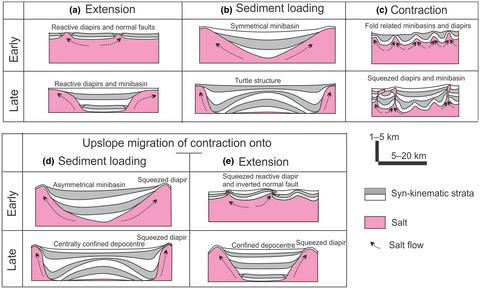当前位置:
X-MOL 学术
›
Basin Res.
›
论文详情
Our official English website, www.x-mol.net, welcomes your
feedback! (Note: you will need to create a separate account there.)
Spatial and temporal variations in minibasin geometry and evolution in salt tectonic provinces: Lower Congo Basin, offshore Angola
Basin Research ( IF 2.8 ) Pub Date : 2020-06-20 , DOI: 10.1111/bre.12486 Zhiyuan Ge 1, 2, 3 , Rob L. Gawthorpe 3 , Leo Zijerveld 3 , Ayodeji P. Oluboyo 3, 4, 5
Basin Research ( IF 2.8 ) Pub Date : 2020-06-20 , DOI: 10.1111/bre.12486 Zhiyuan Ge 1, 2, 3 , Rob L. Gawthorpe 3 , Leo Zijerveld 3 , Ayodeji P. Oluboyo 3, 4, 5
Affiliation

|
In passive margin salt basins, the distinct kinematic domains of thin‐skinned extension, translation and contraction exert important controls on minibasin evolution. However, the relationship between various salt minibasin geometries and kinematic domain evolution is not clear. In this study, we use a semi‐regional 3D seismic reflection dataset from the Lower Congo Basin, offshore Angola, to investigate the evolution of a network of minibasins and intervening salt walls during thin‐skinned, gravity‐driven salt flow. Widespread thin‐skinned extension occurred during the Cenomanian to Coniacian, accommodated by numerous distributed normal faults that are typically 5–10 km long and spaced 1–4 km across strike within the supra‐salt cover. Subsequently, during the Santonian–Paleocene, multiple, 10–25 km long, 5–7 km wide depocentres progressively grew and linked along strike to form elongate minibasins separated by salt walls of comparable lengths. Simultaneous with the development of the minibasins, thin‐skinned contractional deformation occurred in the southwestern downslope part of the study area, forming folds and thrusts that are up to 20 km long and have a wavelength of 2–4 km. The elongate minibasins evolved into turtle structures during the Eocene to Oligocene. From the Miocene onwards, contraction of the supra‐salt cover caused squeezing and uplift of the salt walls, further confining the minibasin depocentres. We find kinematic domains of extension, translation and contraction control the minibasin initiation and subsequent evolution. However, we also observe variations in minibasin geometries associated with along‐strike growth and linkage of depocentres. Neighbouring minibasins may have different subsidence rates and maturity leading to marked variations in their geometry. Additionally, migration of the contractional domain upslope and multiple phases of thin‐skinned salt tectonics further complicates the spatial variations in minibasin geometry and evolution. This study suggests that minibasin growth is more variable and complex than existing domain‐controlled models would suggest.
中文翻译:

盐构造省小盆地几何结构的时空变化及其演化:安哥拉近海盆地
在被动边缘盐盆地中,薄皮伸展,平移和收缩的独特运动学区域对小流域的演化具有重要的控制作用。但是,各种盐小流域几何形状和运动域演化之间的关系尚不清楚。在这项研究中,我们使用来自安哥拉近海下刚果盆地的半区域3D地震反射数据集,来研究在薄皮重力驱动的盐流过程中小盆地和中间盐壁网络的演化。广泛的薄皮扩张发生在西诺曼期至柯尼西亚时期,由众多分布的正断层所容纳,这些断层通常长5–10 km,在超盐覆盖层之间的走向间隔1–4 km。随后,在Santonian–古新世期间,多处10–25 km长,5-7公里宽的沉积中心逐渐增加并沿着走向连接在一起,形成细长的小盆地,这些盆地由相当长度的盐壁隔开。随着小盆地的发展,在研究区域的西南下坡部分发生了薄皮的收缩变形,形成了长达20 km的褶皱和逆冲,波长为2-4 km。在始新世至渐新世期间,细长的小流域演变成乌龟结构。从中新世开始,超盐覆盖层的收缩引起盐壁的挤压和隆升,进一步限制了小盆地的沉积中心。我们发现运动学领域的延伸,翻译和收缩控制小盆地的启动和随后的演变。然而,我们还观察到小径流的几何形状与沿线走向的增长和沉积中心的联系有关。邻近的小盆地可能具有不同的沉降率和成熟度,从而导致其几何形状发生明显变化。此外,收缩域上坡的迁移和薄皮盐构造的多个阶段进一步使小型盆地的几何形状和演化的空间变化复杂化。这项研究表明,小流域的增长比现有的域控制模型所表明的更加可变和复杂。收缩域上坡的迁移和薄皮盐构造的多个阶段进一步使小型盆地的几何形状和演化的空间变化复杂化。这项研究表明,小流域的增长比现有的域控制模型所表明的更加可变和复杂。收缩域上坡的迁移和薄皮盐构造的多个阶段进一步使小型盆地的几何形状和演化的空间变化复杂化。这项研究表明,小流域的增长比现有的域控制模型所表明的更加可变和复杂。
更新日期:2020-06-20
中文翻译:

盐构造省小盆地几何结构的时空变化及其演化:安哥拉近海盆地
在被动边缘盐盆地中,薄皮伸展,平移和收缩的独特运动学区域对小流域的演化具有重要的控制作用。但是,各种盐小流域几何形状和运动域演化之间的关系尚不清楚。在这项研究中,我们使用来自安哥拉近海下刚果盆地的半区域3D地震反射数据集,来研究在薄皮重力驱动的盐流过程中小盆地和中间盐壁网络的演化。广泛的薄皮扩张发生在西诺曼期至柯尼西亚时期,由众多分布的正断层所容纳,这些断层通常长5–10 km,在超盐覆盖层之间的走向间隔1–4 km。随后,在Santonian–古新世期间,多处10–25 km长,5-7公里宽的沉积中心逐渐增加并沿着走向连接在一起,形成细长的小盆地,这些盆地由相当长度的盐壁隔开。随着小盆地的发展,在研究区域的西南下坡部分发生了薄皮的收缩变形,形成了长达20 km的褶皱和逆冲,波长为2-4 km。在始新世至渐新世期间,细长的小流域演变成乌龟结构。从中新世开始,超盐覆盖层的收缩引起盐壁的挤压和隆升,进一步限制了小盆地的沉积中心。我们发现运动学领域的延伸,翻译和收缩控制小盆地的启动和随后的演变。然而,我们还观察到小径流的几何形状与沿线走向的增长和沉积中心的联系有关。邻近的小盆地可能具有不同的沉降率和成熟度,从而导致其几何形状发生明显变化。此外,收缩域上坡的迁移和薄皮盐构造的多个阶段进一步使小型盆地的几何形状和演化的空间变化复杂化。这项研究表明,小流域的增长比现有的域控制模型所表明的更加可变和复杂。收缩域上坡的迁移和薄皮盐构造的多个阶段进一步使小型盆地的几何形状和演化的空间变化复杂化。这项研究表明,小流域的增长比现有的域控制模型所表明的更加可变和复杂。收缩域上坡的迁移和薄皮盐构造的多个阶段进一步使小型盆地的几何形状和演化的空间变化复杂化。这项研究表明,小流域的增长比现有的域控制模型所表明的更加可变和复杂。











































 京公网安备 11010802027423号
京公网安备 11010802027423号